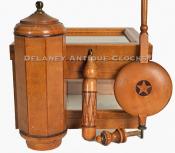Charles Alvah Smith of Brattleboro, Vermont. No. 370. A wag-on-the-wall. 220037.
This Vermont-made treasure measures approximately 26 inches long from the top of the bonnet to the bottom of the pendulum. The backboard is 13 inches tall and 6.75 inches wide. This clock mounted on the wall stands out approximately 5.25 inches. The case is constructed in maple, exhibiting a tiger maple grain pattern. The case, weight, and pendulum are also inlaid.
This is a very attractive example, and it is signed and dated by the Clockmaker July 1943, number 370. The case is designed to be hung on the wall. It is constructed in maple, which exhibits good tiger striping. The grain pattern in tiger maple is interesting and is enhanced with a lovely honey-tinted finish. This case is also inlaid. The inlay pattern used is a linear form assembled from tiny concentric squares. This pattern is placed along the perimeter of the backboard and on the front of the hood. The case joinery is tight and well-executed.
The wooden geared movement is wonderfully made and nicely detailed. It features a roller verge. Windows on the sides of the case allow one to inspect the gearing without removing the hood. This clock is powered by a weight that is decoratively designed. The weight is lead. The slug is encased in an eight-sided decorative lined inlaid wooden canister. The top and bottom are fitted with turned caps. The length of the drop determines the duration of the clock's run. From a normal mounting position, this clock will run for almost two days. This drive system requires a counterweight. This is also constructed of wood and is decorated. The pendulum bob is suspended by a turned and nicely shaped wooden rod. The bob is decorated with an inlaid star.
The dial is paper and applied to a wooden backboard. The graphics drawn on the paper illustrates Smith's drafting skills. The hands are shaped in maple and indicate the time on a time ring that features Roman-style hour numerals.
This very decorative example is signed and dated. It is numbered 370. Apparently, all of Charles Alva Smith's production is signed, dated, and numbered.
Inventory number 220037.
Charles Alvah Smith was a maker of very interesting wooden cased and wooden geared clocks. He was born on his grandfather’s farm in Guilford, Vermont, on November 3, 1866. His parents, Sanford Alvah Smith and Ellen (Hunt) Smith, had three children. His father, Sanford, owned and operated a business that made carriages for children and later other various wood products like wooden sleds, tricycles, and children’s toys. Charles joined this business in 1889 and quickly moved up through the company ranks. It is here that he learned the trade of fine woodworking. Sometime around 1820, Charles retired after 35 years of involvement in the family business. While in retirement, he developed many relationships with various local business enterprises as a designer. A clever person, he was awarded as many as six patents that are mechanical in nature. One patent is for a foot pedal starter used in an automobile. A patent second was for a circular wood-cutting table saw. An example of his involvement with local businesses was his involvement with the Franklin Motor Car Company. He advised their planning and production divisions.
Charles was a Yankee. He collected wood scraps from his furniture-making business and began making clocks in his home workshop. He first presented them as gifts and soon went into production sometime in 1931 until he died in 1946. During this time, he produced approximately 619 clocks. In fact, No. 619 is a clock that I have seen. Charles made each clock from start to finish. He made the entire clock to his very high-quality standards. For additional information regarding his interesting person, please read Charles Alvah Smith: Vermont Maker of Unusual Wood Clocks, written by John M. Anderson. This is a soft cover, 60-plus page description of this ingenious Yankee clockmaker, which was published by the National Association of Watch and Clock Collectors (NAWCC) in December of 1990.
We have owned and seen a fair number of these clocks over the years. Some of the numbers include numbers 10,109,138,162, 203, 266, 366, 368, 484, 493, 495, 506, 573, 605 and 607.










